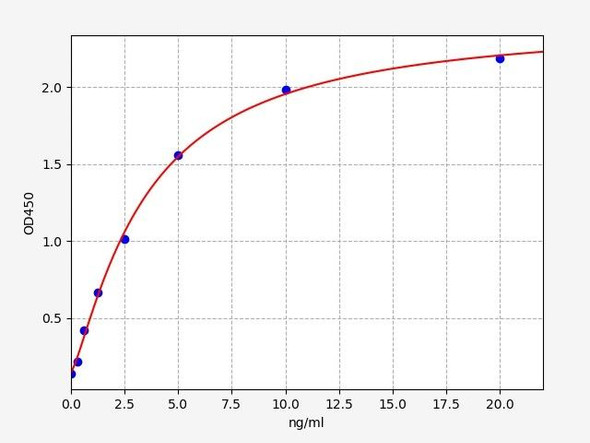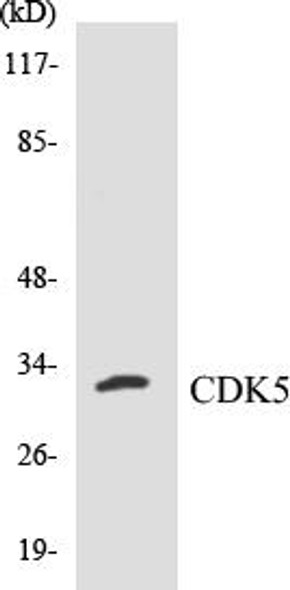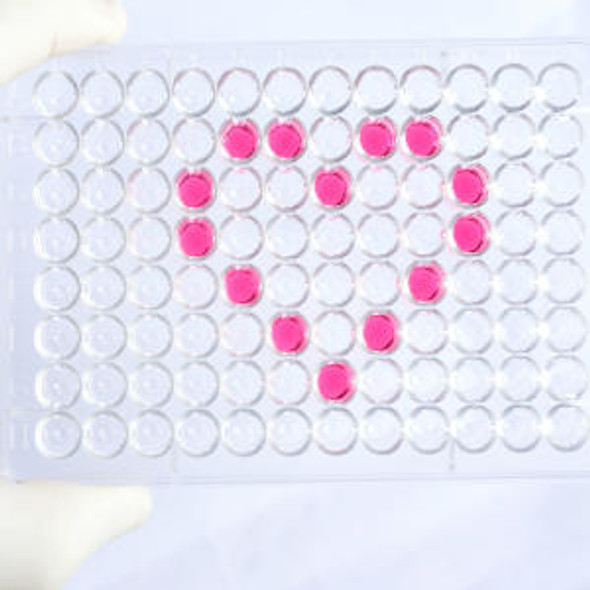Mouse Cell Death ELISA Kits
Mouse CDK5 ELISA Kit
- SKU:
- MOFI00708
- Product Type:
- ELISA Kit
- Size:
- 96 Assays
- Uniprot:
- P49615
- Sensitivity:
- 0.094ng/ml
- Range:
- 0.156-10ng/ml
- ELISA Type:
- Sandwich
- Synonyms:
- CDK5, Cyclin-dependent kinase 5, TPKII catalytic subunit, Tau protein kinase II catalytic subunit, Cell division protein kinase 5, Serine, threonine-protein kinase PSSALRE
- Reactivity:
- Mouse
- Research Area:
- Cell Death
Description
| Product Name: | Mouse CDK5 ELISA Kit |
| Product Code: | MOFI00708 |
| Size: | 96 Assays |
| Alias: | CDK5, Cyclin-dependent kinase 5, TPKII catalytic subunit, Tau protein kinase II catalytic subunit, Cell division protein kinase 5, Serine, threonine-protein kinase PSSALRE |
| Detection Method: | Sandwich ELISA |
| Application: | This immunoassay kit allows for the in vitro quantitative determination of Mouse CDK5 concentrations in serum plasma and other biological fluids. |
| Sensitivity: | 0.094ng/ml |
| Range: | 0.156-10ng/ml |
| Storage: | 4°C for 6 months |
| Note: | For Research Use Only |
| Recovery: | Matrices listed below were spiked with certain level of Mouse CDK5 and the recovery rates were calculated by comparing the measured value to the expected amount of Mouse CDK5 in samples. | ||||||||||||||||
| |||||||||||||||||
| Linearity: | The linearity of the kit was assayed by testing samples spiked with appropriate concentration of Mouse CDK5 and their serial dilutions. The results were demonstrated by the percentage of calculated concentration to the expected. | ||||||||||||||||
| |||||||||||||||||
| Intra Assay: | CV <8% | ||||||||||||||||
| Inter Assay: | CV <10% |
| Component | Quantity | Storage |
| ELISA Microplate (Dismountable) | 8-12 strips | 4°C for 6 months |
| Lyophilized Standard | 2 | 4°C/-20°C |
| Sample/Standard Dilution Buffer | 20ml | 4°C |
| Biotin-labeled Antibody(Concentrated) | 120ul | 4°C (Protect from light) |
| Antibody Dilution Buffer | 10ml | 4°C |
| HRP-Streptavidin Conjugate(SABC) | 120ul | 4°C (Protect from light) |
| SABC Dilution Buffer | 10ml | 4°C |
| TMB Substrate | 10ml | 4°C (Protect from light) |
| Stop Solution | 10ml | 4°C |
| Wash Buffer(25X) | 30ml | 4°C |
| Plate Sealer | 5 | - |
Other materials and equipment required:
- Microplate reader with 450 nm wavelength filter
- Multichannel Pipette, Pipette, microcentrifuge tubes and disposable pipette tips
- Incubator
- Deionized or distilled water
- Absorbent paper
- Buffer resevoir
| Uniprot | P49615 |
| UniProt Protein Function: | CDK5: a protein kinase of the CDK family. Unlike other members of this family, it is not activated by cyclins but by p35 (CDK5R1) and p39. An important regulator of neuronal positioning during brain development. May also play a role in synaptogenesis and neurotransmission. Substrates include TAU, MAP2, NF-H and -M, Nudel, PDE6, beta-catenin, amphyphysin, dynamin I, synapsin 1, Munc-18, and NMDA receptor 2A. Plays a role in myogenesis, haematopoietic cell differentiation, spermatogenesis, insulin secretion, and lens differentiation. Implicated in the pathology of neurofibrillary tangles and formation of senile plaques, hallmarks of Alzheimer?s disease. Induces tau phosphorylation and aggregation and neurofibrillary tangle deposition and neurodegeneration in in vitro and in vivo animal models. Brain samples from Alzeimer?s pateints show elevated CDK5 activity. |
| UniProt Protein Details: | Protein type:Protein kinase, Ser/Thr (non-receptor); Cell cycle regulation; Kinase, protein; Protein kinase, CMGC; EC 2.7.11.1; CMGC group; CDK family; CDK5 subfamily; CDK/CDK5 subfamily Cellular Component: cyclin-dependent protein kinase 5 activator complex; cell; dendrite; postsynaptic density; cytosol; postsynaptic membrane; growth cone; cytoskeleton; cell projection; cell soma; membrane; axon; lamellipodium; cytoplasm; nucleolus; plasma membrane; synapse; intracellular; neuromuscular junction; nucleus; cell junction; filopodium Molecular Function:acetylcholine receptor activator activity; ephrin receptor binding; p53 binding; nucleotide binding; protein kinase binding; protein kinase activity; transferase activity; protein serine/threonine kinase activity; ErbB-2 class receptor binding; protein binding; ErbB-3 class receptor binding; cyclin-dependent protein kinase activity; tau-protein kinase activity; transferase activity, transferring phosphorus-containing groups; cytoskeletal protein binding; kinase activity; ATP binding Biological Process: Schwann cell development; negative regulation of synaptic plasticity; regulation of cell cycle; cerebellar cortex formation; rhythmic process; regulation of synaptic plasticity; motor axon guidance; sensory perception of pain; receptor clustering; protein amino acid phosphorylation; regulation of cell migration; corpus callosum development; neuron differentiation; cerebellar cortex development; receptor catabolic process; oligodendrocyte differentiation; cerebellum development; neurite development; central nervous system neuron development; synaptic transmission, glutamatergic; nervous system development; skeletal muscle development; dendrite morphogenesis; regulation of postsynaptic membrane potential; cell division; synaptic vesicle endocytosis; negative regulation of protein ubiquitination; cerebral cortex development; negative regulation of transcription, DNA-dependent; synaptic transmission, dopaminergic; regulated secretory pathway; negative regulation of protein export from nucleus; exocytosis; positive regulation of protein binding; apoptosis; cell-matrix adhesion; protein amino acid autophosphorylation; neuron migration; nucleocytoplasmic transport; negative regulation of axon extension; negative regulation of cell cycle; intracellular protein transport; synaptogenesis; behavioral response to cocaine; positive regulation of neuron apoptosis; forebrain development; response to wounding; visual learning; cortical actin cytoskeleton organization and biogenesis; associative learning; layer formation in the cerebral cortex; serine phosphorylation of STAT3 protein; negative regulation of proteolysis; cell migration; hippocampus development; peptidyl-threonine phosphorylation; cell cycle; response to cocaine; positive regulation of calcium ion-dependent exocytosis; telencephalon development; peptidyl-serine phosphorylation; neuron apoptosis; axonogenesis; positive regulation of protein kinase activity; regulation of excitatory postsynaptic membrane potential; phosphorylation; neurite morphogenesis |
| UniProt Code: | P49615 |
| NCBI GenInfo Identifier: | 6680908 |
| NCBI Gene ID: | 12568 |
| NCBI Accession: | NP_031694.1 |
| UniProt Related Accession: | P49615 |
| Molecular Weight: | 33,288 Da |
| NCBI Full Name: | cyclin-dependent kinase 5 |
| NCBI Synonym Full Names: | cyclin-dependent kinase 5 |
| NCBI Official Symbol: | Cdk5 |
| NCBI Official Synonym Symbols: | Crk6; AW048668 |
| NCBI Protein Information: | cyclin-dependent-like kinase 5; CR6 protein kinase; TPKII catalytic subunit; cell division protein kinase 5; serine/threonine-protein kinase PSSALRE; tau protein kinase II catalytic subunit |
| UniProt Protein Name: | Cyclin-dependent-like kinase 5 |
| UniProt Synonym Protein Names: | CR6 protein kinase; CRK6; Cell division protein kinase 5; Serine/threonine-protein kinase PSSALRE; Tau protein kinase II catalytic subunit; TPKII catalytic subunit |
| Protein Family: | Cyclin-dependent kinase |
| UniProt Gene Name: | Cdk5 |
| UniProt Entry Name: | CDK5_MOUSE |
*Note: Protocols are specific to each batch/lot. For the correct instructions please follow the protocol included in your kit.
| Step | Procedure |
| 1. | Set standard, test sample and control (zero) wells on the pre-coated plate respectively, and then, record their positions. It is recommended to measure each standard and sample in duplicate. Wash plate 2 times before adding standard, sample and control (zero) wells! |
| 2. | Aliquot 0.1ml standard solutions into the standard wells. |
| 3. | Add 0.1 ml of Sample / Standard dilution buffer into the control (zero) well. |
| 4. | Add 0.1 ml of properly diluted sample (Human serum, plasma, tissue homogenates and other biological fluids.) into test sample wells. |
| 5. | Seal the plate with a cover and incubate at 37 °C for 90 min. |
| 6. | Remove the cover and discard the plate content, clap the plate on the absorbent filter papers or other absorbent material. Do NOT let the wells completely dry at any time. Wash plate X2. |
| 7. | Add 0.1 ml of Biotin- detection antibody working solution into the above wells (standard, test sample & zero wells). Add the solution at the bottom of each well without touching the side wall. |
| 8. | Seal the plate with a cover and incubate at 37°C for 60 min. |
| 9. | Remove the cover, and wash plate 3 times with Wash buffer. Let wash buffer rest in wells for 1 min between each wash. |
| 10. | Add 0.1 ml of SABC working solution into each well, cover the plate and incubate at 37°C for 30 min. |
| 11. | Remove the cover and wash plate 5 times with Wash buffer, and each time let the wash buffer stay in the wells for 1-2 min. |
| 12. | Add 90 µL of TMB substrate into each well, cover the plate and incubate at 37°C in dark within 10-20 min. (Note: This incubation time is for reference use only, the optimal time should be determined by end user.) And the shades of blue can be seen in the first 3-4 wells (with most concentrated standard solutions), the other wells show no obvious color. |
| 13. | Add 50 µL of Stop solution into each well and mix thoroughly. The color changes into yellow immediately. |
| 14. | Read the O.D. absorbance at 450 nm in a microplate reader immediately after adding the stop solution. |
When carrying out an ELISA assay it is important to prepare your samples in order to achieve the best possible results. Below we have a list of procedures for the preparation of samples for different sample types.
| Sample Type | Protocol |
| Serum: | If using serum separator tubes, allow samples to clot for 30 minutes at room temperature. Centrifuge for 10 minutes at 1,000x g. Collect the serum fraction and assay promptly or aliquot and store the samples at -80°C. Avoid multiple freeze-thaw cycles. If serum separator tubes are not being used, allow samples to clot overnight at 2-8°C. Centrifuge for 10 minutes at 1,000x g. Remove serum and assay promptly or aliquot and store the samples at -80°C. Avoid multiple freeze-thaw cycles. |
| Plasma: | Collect plasma using EDTA or heparin as an anticoagulant. Centrifuge samples at 4°C for 15 mins at 1000 - g within 30 mins of collection. Collect the plasma fraction and assay promptly or aliquot and store the samples at -80°C. Avoid multiple freeze-thaw cycles. Note: Over haemolysed samples are not suitable for use with this kit. |
| Urine & Cerebrospinal Fluid: | Collect the urine (mid-stream) in a sterile container, centrifuge for 20 mins at 2000-3000 rpm. Remove supernatant and assay immediately. If any precipitation is detected, repeat the centrifugation step. A similar protocol can be used for cerebrospinal fluid. |
| Cell culture supernatant: | Collect the cell culture media by pipette, followed by centrifugation at 4°C for 20 mins at 1500 rpm. Collect the clear supernatant and assay immediately. |
| Cell lysates: | Solubilize cells in lysis buffer and allow to sit on ice for 30 minutes. Centrifuge tubes at 14,000 x g for 5 minutes to remove insoluble material. Aliquot the supernatant into a new tube and discard the remaining whole cell extract. Quantify total protein concentration using a total protein assay. Assay immediately or aliquot and store at ≤ -20°C. |
| Tissue homogenates: | The preparation of tissue homogenates will vary depending upon tissue type. Rinse tissue with 1X PBS to remove excess blood & homogenize in 20ml of 1X PBS (including protease inhibitors) and store overnight at ≤ -20°C. Two freeze-thaw cycles are required to break the cell membranes. To further disrupt the cell membranes you can sonicate the samples. Centrifuge homogenates for 5 mins at 5000xg. Remove the supernatant and assay immediately or aliquot and store at -20°C or -80°C. |
| Tissue lysates: | Rinse tissue with PBS, cut into 1-2 mm pieces, and homogenize with a tissue homogenizer in PBS. Add an equal volume of RIPA buffer containing protease inhibitors and lyse tissues at room temperature for 30 minutes with gentle agitation. Centrifuge to remove debris. Quantify total protein concentration using a total protein assay. Assay immediately or aliquot and store at ≤ -20 °C. |
| Breast Milk: | Collect milk samples and centrifuge at 10,000 x g for 60 min at 4°C. Aliquot the supernatant and assay. For long term use, store samples at -80°C. Minimize freeze/thaw cycles. |






